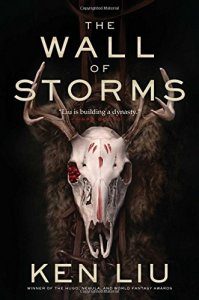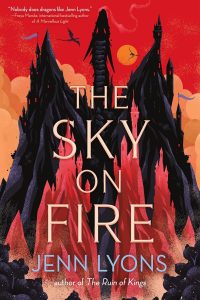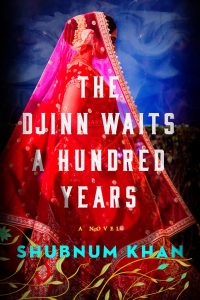Gary K. Wolfe reviews Ken Liu
The Wall of Storms, Ken Liu (Saga 978-1-4814-2430-1, $29.99, 860pp, hc) October 2016.
 In one of those enjoyable but pointless convention barroom debates a few years ago, I found myself drawn into the question of whether the term ‘‘fantasy novel’’ is a redundancy or an oxymoron. The argument, as I recall it (and I don’t remember who started it, since alcohol was certainly involved), was whether the traditional literary novel as inherited from the Victorians and the modernists (not simply defined by length) was fundamentally a separate art form from fantasy, setting out to do quite different things – valorizing interiority over spectacle, for example, or character over invention. A true fantasy novel, one of my tablemates decided, would need to somehow achieve both goals without fatally wounding one or the other – which is why the true fantasy ‘‘novel’’ was comparatively rare. It would, for example have to make us worry equally about the depredations of fire-breathing dragons and anxiety over upcoming SATs.
In one of those enjoyable but pointless convention barroom debates a few years ago, I found myself drawn into the question of whether the term ‘‘fantasy novel’’ is a redundancy or an oxymoron. The argument, as I recall it (and I don’t remember who started it, since alcohol was certainly involved), was whether the traditional literary novel as inherited from the Victorians and the modernists (not simply defined by length) was fundamentally a separate art form from fantasy, setting out to do quite different things – valorizing interiority over spectacle, for example, or character over invention. A true fantasy novel, one of my tablemates decided, would need to somehow achieve both goals without fatally wounding one or the other – which is why the true fantasy ‘‘novel’’ was comparatively rare. It would, for example have to make us worry equally about the depredations of fire-breathing dragons and anxiety over upcoming SATs.
That is, more or less, what Ken Liu does in The Wall of Storms, the second of his Dandelion Dynasty novels, longer by a third than 2015’s The Grace of Kings. While the fire-breathing dragons, here called garinafins, do show up for some spectacular battle scenes later on, much of the first quarter of the novel details the childhood and education of Zomi Kidosu, a poor but brilliant girl from a remote village, and her eventual preparations for the highly competitive Grand Examinations – OK, not quite the SATs, but a version of the actual career-defining imperial examinations which were instituted as early as the Han dynasty, the historical basis for Liu’s Dandelion dynasty. Evaluated on such matters as philosophy, argumentation, and even calligraphy, the exams favor the sons of the wealthy, which makes Zomi’s eventual success all the more remarkable – although we learn that she’s been taken under the wing of an itinerant tutor with deep connections to the royal family. Zomi is the most appealing character in the novel, not simply because she plays the familiar role of the lower-class outsider who becomes a game-changer in society (a role filled by now-emperor Kuni Garu in the first volume), but because she accomplishes this through intellect rather than through battle skills.
In fact, intellect is one of the defining features of Liu’s approach to fantasy. Kuni Garu, who we first met as an ingenious con artist, now faces the real challenges of governing the Dara archipelago – disaffected nobles to whom, ironically, he may have given too much independence; would-be revolutionaries still loyal to his former rival Mata Zyndu; his own ambitious but squabbling children; and, eventually, a threat to the very survival of his dynasty from ruthless invaders riding those incendiary dragons. As the novel opens, three of those royal children – the quiet and scholarly Timu, the colorful and passionate Phyro, and the more balanced Thera – are slumming incognito in a local pub when a storyteller is challenged by a con artist pretending to be a government agent, who in turn is successfully challenged by Zomi, but not before a brawl which results in losing her irreplaceable ticket to the examinations. The royal kids set out to use their connections to obtain a new ticket, and already Zomi’s fate is bound up in that of the dynasty.
The rest of the action unfolds over the next six years, as the children come of age and join their father’s government (to somewhat mixed results, as he tries to choose his heir), but with frequent flashbacks recounting such things as Zomi’s childhood – including a near-mystical experience of being struck by lightning, which deformed her leg and altered her life in even more significant ways – and the harrowing experiences of Kuni’s beloved adviser Luan, eventually captured by the fearsome Lyucu and their brutal leader Tenryo. Tenryo is prevented from invading Dara only by the Wall of Storms, a zone of endlessly violent weather that is as unlikely meteorologically as it is awe-inspiring dramatically. But the governing weather metaphor is important, as the escalating stakes of the novel are telegraphed by section titles like ‘‘Whispering Breezes’’, ‘‘Gusts and Gales’’, ‘‘Tempest from the North’’, and ‘‘Clash of Typhoons’’. The war with the Lyucu dominates the novel’s second half, but again – despite some impressive acrobatic heroics and battles described with exceptional clarity and coherence – its outcome depends largely on convincingly worked-out tactics and even research and development – in other words, a war finally won by intellect, in keeping with the novel’s clearly articulated values. The Wall of Storms is a far more complex and rewarding novel than The Grace of Kings – unusual for the middle book in a series, and equally unusual is that it can be appreciated largely as a standalone. The characters we met earlier, including Kuni himself, his wife Jia, and his consort Risana, also prove more complex and sometimes surprising, given what we might have expected of them from the first novel. It took a while for The Grace of Kings to bring many female characters to center stage, but they’re firmly there from the beginning of The Wall of Storms, and it only adds to the richness of a world that – we now realize – Liu had only begun to explore in his first volume.





